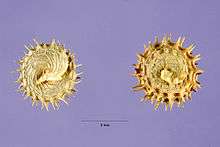Medicago polymorpha
| Medicago polymorpha | |
|---|---|
.jpg) | |
| Scientific classification | |
| Kingdom: | Plantae |
| (unranked): | Angiosperms |
| (unranked): | Eudicots |
| (unranked): | Rosids |
| Order: | Fabales |
| Family: | Fabaceae |
| Subfamily: | Faboideae |
| Genus: | Medicago |
| Species: | M. polymorpha |
| Binomial name | |
| Medicago polymorpha L. | |
| Synonyms | |
|
M. apiculata Willd. | |
Medicago polymorpha is a plant species of the genus Medicago. It is native to the Mediterranean basin but is found throughout the world. It forms a symbiotic relationship with the bacterium Sinorhizobium medicae, which is capable of nitrogen fixation. Common names include California burclover, toothed bur clover, toothed medick and burr medic.

| Wikispecies has information related to: Medicago polymorpha |
| Wikimedia Commons has media related to Medicago polymorpha. |
Description
This weedy forb is an annual broadleaf plant. It inhabits agricultural land, roadsides and other disturbed areas. It is found in lawns as well, where its burrs are able to cling to the clothing or fur of any species that pass near it, thus facilitating geographic spread via these seed capsules. Burclover is forage for livestock, but the fruit is prickly. It makes for a poor lawn in the late summer, when the leaves have yellowed and fruit sets into the 7 mm seed heads that are covered with hooked prickles.
New seedlings have seed leaves that are oblong. The first true leaf is rounded. Later leaves will be tripartite, with a characteristic clover-like shape, appearing alternately on the stems. Leaflets have slightly serrated edges. The tiny yellow flowers attract small butterflies and other pollinating insects.
Full grown plant stems are up to 2 feet (60 cm) long, and usually sprawl along and/or under the ground. The stems often root at the nodes; adult plants, and even young plants that have been able to grow for a few weeks undisturbed can be very difficult to pull out, leaving behind tap roots and a network of plant pieces when pulled. Mechanically removing top growth from this plant will not usually eradicate it.
Being a member of the Leguminosae family, the flowers are clover-like, lipped and clustered. Bloom takes place from March to June in the plant's native territory. Flowers (3-6 mm long) are small, bright yellow, and cluster into flower heads of 2 to 10 flowers at the stem tips. The fruit is a pod that coils tightly 2 to 6 times and has rows of prickles on the outside edge of the pod. The fruits are about 6-7 mm across. They start out green and relatively soft, but quickly turn brown and hard. Inside the pod are several seeds—usually yellow or tan and kidney shaped. The burred fruiting bodies can be quite difficult to remove from softer fabrics, such as fleeces and knitted socks.[1][2][3]